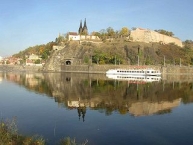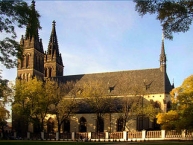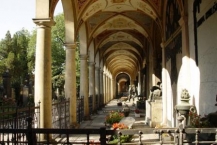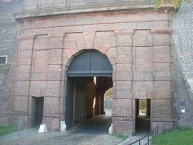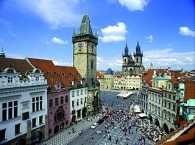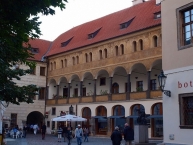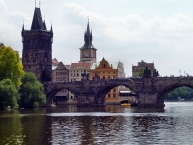Cycle Tour Prague - Kassel
Planned tour
Actions
![]()
Please wait - map data are loading
Added on 06 Dec 2011,
last edited by ThimbleU on 06 Dec 2011
Actions
Cycle route metrics
planned
ridden
Total distance in km
818
0
Cumulative elevation gain in m
6.117
0
Avg. slope uphill in %
0,75
-
Cumulative elevation loss in m
6.128
0
Information about rights to the gps-track data | |
|---|---|
Rights owner | |
Rights characteristic / license | by-nc-sa: CREATIVE COMMONS Attribution-NonCommercial-ShareAlike |
Link to the description of the license | |
GPX file uploaded | by ThimbleU on 06 Dec 2011
|
Track points in total
4.512
0
Track points per km (avg)
6
0
Start/endpoint
Start location
Praha, Praha, CZ (201 m NHN)
End location
Kassel, Hessen, DE (190 m NHN)
Beds4Cyclists, worth visiting and infrastructure
Name and address
Latitude / Longitude
Phone
Fax
Mobile
Type of accommodation
Rating for cyclists
Route km
Dist. to route
Elevation
0 km
2,6 km
228 m
Information about copyright | |
|---|---|
Rights owner | |
Rights characteristic / license | cc0: Public Domain no Rights reserved |
Link to the description of the license | |
Image taken over from | commons.wikimedia.org/wiki/File:Vysehrad_as_seen_over_the_Vltava_from_Cisarska_louka_732.jpg |
Image has been uploaded | by biroto-Redaktion on 27 Nov 2012
|
Information about copyright | |
|---|---|
Rights owner | |
Rights characteristic / license | cc0: Public Domain no Rights reserved |
Link to the description of the license | |
Image taken over from | commons.wikimedia.org/wiki/File:SS_Peter_and_Paul_church_Vysehrad_Prageu_CZ_821.jpg |
Image has been uploaded | by biroto-Redaktion on 27 Nov 2012
|
Information about copyright | |
|---|---|
Rights owner | |
Rights characteristic / license | cc0: Public Domain no Rights reserved |
Link to the description of the license | |
Image taken over from | commons.wikimedia.org/wiki/File:Vysehrad_hrbitov_cemetary1.JPG |
Image has been uploaded | by biroto-Redaktion on 28 Nov 2012
|
Information about copyright | |
|---|---|
Rights owner | |
Rights characteristic / license | by-sa: CREATIVE COMMONS Attribution-ShareAlike |
Link to the description of the license | |
Image taken over from | commons.wikimedia.org/wiki/File:Brick_Gate_Vysehrad_Prague_CZ_744.jpg |
Image has been uploaded | by biroto-Redaktion on 28 Nov 2012
|
Der Vyšehrad (deutsch: Wyschehrad oder Prager Hochburg) ist einer der bekanntesten frühmittelalterlichen Burgwälle in Böhmen. Er liegt südlich der Prager Innenstadt auf einem Hügel, der sich steil über dem rechten Ufer der Moldau (Vltava) erhebt. Als zweite Prager Burg des Herrschergeschlechts der Přemysliden bereits im 10. Jahrhundert gegründet, wurde er in der Romanik und Gotik mehrfach ausgebaut. Die heutige Gestalt wird jedoch wesentlich durch den Umbau zu einer barocken Festung bestimmt. Innerhalb der Burg befindet sich auch die St.-Peter-und-Paul-Kirche und der Vyšehrader Friedhof
, auf dem zahlreiche Künstler, Wissenschaftler und Politiker bestattet sind.
Nach Karls Tod war der Vyšehrad vor allem eine Priesterstadt, in der über 100 Geistliche etwa zehn oder mehr Sakralräume betreuten. 1420 wurden Burg und Immunität durch die Hussiten erobert und dabei nahezu alle Bauten zerstört. Im 15. Jahrhundert entstand die mehrheitlich von kleinen Handwerkern bewohnte „Freistadt auf dem Berge Vyšehrad“. Mit der Gegenreformation fiel das Gelände 1620 an das Kapitel zurück und es kam zunehmend zu Differenzen mit den eingesessenen Bewohnern.
Nachdem die militärtechnisch veraltete Burganlage 1648 bei einem Angriff der Schweden schwer beschädigt worden war, wurde sie 1654–1680 zu einer Barockfestung ausgebaut. Für die gewaltigen Schanzen aus Backsteinmauerwerk und die schweren Eckbasteien, die nach Heiligen benannt sind, wurde die Bevölkerung vertrieben und Gebäude abgerissen. Die Festung wurde 1866 aufgehoben und bald darauf als sechstes Stadtviertel Prag angegliedert. 1911 wurde sie weitgehend geschleift.
Kollegiatstift St. Peter und Paul
Die St.-Peter-und-Paul-Kirche (Kostel sv. Petra a Pavla) wurde in den 1070er Jahren unter Vratislav II. als Kollegiatstiftskirche des Vyšehrader Kapitels gegründet. Gleichzeitig diente sie als Grabkirche, in der vier přemyslidische Herzöge bestattet worden sind. Die heutige Gestalt geht vor allem auf eine 1885–1887 erfolgte neogotische Umgestaltung durch Josef Mocker zurück, die dominierende Doppelturmfassade wurde erst 1902–1903 angefügt. Auch der Fassadenschmuck und die Innenausstattung stammen fast ausschließlich aus dieser Zeit.
Vyšehrader Friedhof 
An die Kirche schließt sich der Vyšehrader Friedhof (Vyšehradský hřbitov) an, der bedeutendste Prager Friedhof, auf dem unter anderem die Komponisten Antonín Dvořák, Bedřich Smetana und Rafael Kubelík sowie der Dichter und Journalist Jan Neruda ihre letzte Ruhe gefunden haben, ebenfalls fand hier die große tschechische Opernsängerin Ema Destinová ihre letzte Ruhestätte.
Kapelle der Jungfrau Maria an den Schanzen
Die Kapelle der Jungfrau Maria an den Schanzen (Kaple Panny Marie v hradbách) ist eine Wallfahrtsstätte aus der Mitte des 18. Jahrhunderts für die Skulptur der Jungfrau Maria von Loreto (heute in St. Peter und Paul). Die Kirche wurde 1784 durch Joseph II. aufgehoben, knapp ein Jahrhundert später jedoch neu geweiht.
Alte und Neue Propstei
Die Alte Propstei (Staré proboštství) entstand in der ersten Hälfte des 18. Jahrhunderts und zeigt noch Fragmente alter Freskogemälde. Die Neue Propstei (Nové propoštství) ist ein neogotischer Bau aus dem Jahr 1872.
Sankt-Martins-Rotunde
Die Sankt-Martinsrotunde (Rotunda sv. Martina) ist das einzige Baudenkmal des Vyšehrads, das in seiner ursprünglichen Gestalt erhalten geblieben ist. Sie ist gleichzeitig die älteste Rotunde Prags, die wahrscheinlich noch im letzten Drittel des 11. Jahrhundert unter Vratislav II. als Pfarrkirche der Vorburg gebaut worden ist.
St.-Laurentius-Basilika
Bei der St. Laurentius Basilika (Kostel sv. Vavřince), einer romanischen Rotunde aus der zweiten Hälfte des 11. Jahrhunderts, handelt es sich um die ursprüngliche, von Vratislav II. errichtete Pfarrkirche der Burg. Die Kirche wurde in den Hussitenkriegen vernichtet. In der Spätgotik wurde unter Verwendung der romanischen Mauern ein neues Domherrenhaus gebaut und die Nordapsis der Kirche in die Hauskapelle des Gebäudes eingebaut, die das Patrozinium übernahm.
Neue Dekanei
Die Neue Dekanei wurde 1877–1879 von J. Nicklas errichtet. Sie beherbergt heute eine Ausstellung zur Geschichte des Vyšehrads und der Kapitelbibliothek.
Vyšehradské sady
Der Park befindet sich an der Stelle des romanischen Wohnbaus („Palas“) und des gotischen Königshofs Karls IV. 1655 wurde hier ein Zeughaus errichtet, das 1927 niederbrannte. Seitdem dient das Gelände als Park.
Burggrafenhaus
Das Burggrafenhaus an der südwestlichen Ecke des Berges ist ein Teil des Palastbezirks Karls IV, der im 16. Jahrhundert umgebaut wurde. Westlich davon sind weitere Reste des 14. Jahrhunderts erhalten, ebenso im ehemaligen Burgturm, der jedoch barock überformt wurde. Er beherbergt eine Ausstellung mit Stichen und alten Darstellungen des Vyšehrads. Unterhalb liegt dicht am Felshang die Ruine eines mittelalterlichen Wachgebäudes.
Tore der Festung
- Von der barocken Festung ist das Chotek
-Tor zu nennen, das als jüngstes Tor im Empirestil 1841 erbaut wurde. Hier liegt der Zugang zu Kasematten im Inneren der Barockbefestigung.
- Das Tábor-Tor lag im Südosten noch vor den eigentlichen Schanzen. Es wurde um 1655 im Frühbarock an der äußeren barocken Befestigung errichtet. Dahinter lag die mittelalterliche Vorburg.
- Das Spitze Tor (Špička; V pevnosti Nr. 9/CN 10) bildete den Hauptzugang zum Vyšehrad und war wie auch die anderen vier Stadttore der Neustadt als porta novem pinarum gestaltet, also mit neun Türmchen versehen. Es zeigt noch Mauerreste des von 1348 bis 1350 errichteten Haupttores und ein 140 m langes Teilstück der gotischen Burgmauer, die hier mit der Neustadtbefestigung zusammenstieß.
- Das Leopolds-Tor (Leopoldova brána) lag im inneren Ring der Festung. Carlo Lurago baute es um 1678 anschließend an das Matthiastor der Prager Burg im Stil norditalienischer Festungsarchitektur. Die ursprüngliche Zugbrücke wurde 1842 durch die heutige Straße ersetzt.
Information about copyright | |
|---|---|
Rights characteristic / license | by-sa: CREATIVE COMMONS Attribution-ShareAlike |
Link to the description of the license | |
Input taken over from: |
Seite „Vyšehrad“. In: Wikipedia, Die freie Enzyklopädie. Bearbeitungsstand: 25. Juni 2012, 14:34 UTC. URL: http://de.wikipedia.org/w/index.php?title=Vy%C5%A1ehrad&oldid=104796323 |
taken over / edited on | 28 Nov 2012 - 06 Jul 2021
|
taken over / edited by |
|
0 km
3,6 km
186 m
0 km
0,1 km
204 m
Information about copyright | |
|---|---|
Rights owner | |
Rights characteristic / license | by: CREATIVE COMMONS Attribution |
Link to the description of the license | |
Image taken over from | commons.wikimedia.org/wiki/File:Prague_old_town_square_panorama.jpg |
Image has been uploaded | by biroto-Redaktion on 17 Jun 2012
|
Information about copyright | |
|---|---|
Rights owner | |
Rights characteristic / license | by-sa: CREATIVE COMMONS Attribution-ShareAlike |
Link to the description of the license | |
Image taken over from | commons.wikimedia.org/wiki/File:Prag_Rathaus_Altstädter_Ring.JPG |
Image has been uploaded | by biroto-Redaktion on 17 Jun 2012
|
Information about copyright | |
|---|---|
Rights owner | |
Rights characteristic / license | by-sa: CREATIVE COMMONS Attribution-ShareAlike |
Link to the description of the license | |
Image taken over from | commons.wikimedia.org/wiki/File:Palác_Granovských_z_Granova_01.JPG |
Image has been uploaded | by biroto-Redaktion on 12 Oct 2013
|
Information about copyright | |
|---|---|
Rights owner | |
Rights characteristic / license | by: CREATIVE COMMONS Attribution |
Link to the description of the license | |
Image taken over from | |
Image has been uploaded | by biroto-Redaktion on 12 Oct 2013
|
Old Town and Josefov
The right bank section of District Prague 1, the oldest settled area, consists of the Old Town of Prague ![]() (Czech: Staré město) and the Jewish Town (Czech: Josefov).
(Czech: Staré město) and the Jewish Town (Czech: Josefov).
Understand
The Jewish Quarter lends itself to exploration, contemplation and a deeper understanding of what Prague's Jews have endured throughout the centuries. Paradoxically, Adolf Hitler is to thank for the Quarter's continued existence - he intended to create an "Exotic Museum of an Extinct Race" here after the end of the war.
See
- ⊙Old Town Square (Staroměstské náměstí) is the center of eventful history of Prague. The Gothic, Renaissance and Baroque buildings were preserved here. The Historical Centre, including most of the city’s major sites, became a UNESCO-listed site in 1992.
- ⊙Jan Hus monument (Pomník mistra Jana Husa). That striking man standing atop a patina-green metal mountain in the center of Old Town Square is not Jesus, though he resembles him. It's Jan Hus, the great Czech religious reformer whose Hussite movement caused as much, if not more, friction within the Christian community as Martin Luther.
- ⊙Astronomical Clock (Pražský orloj). The Astronomical Clock located on a side tower of the Old Town Hall (reasonably enough, on Old Town Square) is easy to find - just wait until a few minutes before the hour and look for a large group of tourists standing around waiting for something to happen! It also one of the most popular gathering places in Prague.
Built in 1410 and thought of as an example of 15th century hi-tech device, projected with participation of math and astronomy professor at Prague University. The mail dial is in principle mechanical astrolabe, showing not only the current time, but also the placement of Sun and Moon in Zodiac, phase of the moon, time of sunrise and sunset, length of astronomical night, time in old Bohemian hours, in unequal hours and other data. From gathering crowds, hardly anybody understands all data astronomical dial displays.
Then there is a slow-moving 12-month calendar with incredibly delicate, small figure paintings by 19th century Czech painter Josef Manes. Every day on the hour, the upper, glockenspiel-style section of the clock performs the same scene: Death waves an hourglass, the 12 apostles shuffle past small windows, and a rooster crows. After the hour strikes, a Turk wags his head. - ⊙Municipal Hall (Obecní dům), ☎ +420 222 002101. Nám. Republiky 5. The Obecní dům was built near the Powder Tower (a storage place for gunpowder and a major trade route entry into the city) on a site called King's Court where once a royal residence stood. In 1901, the Prague Civic Society made a proposal to city authorities to build a center for official and social Czech events.
- ⊙Convent of St Agnes, U Milosrdných 17. The Anezsky klaster is the first Early Gothic building in Prague (founded 1234) - something notable in a city filled with amazingly well-preserved examples of Gothic architecture such as St Vitus, the Charles Bridge and the Powder Tower. Over the years the complex's convent, chapels and several churches deteriorated and in some cases, were completely destroyed. After Habsburg emperor Josef II's religious reforms, the convent was shut down in 1782 and converted into lodgings for the poor. Today, the convent is used to house part of the Czech National Gallery's collection. Admission: Full: 100 Kč, Reduced: 50 Kč, Family: 150 Kč.
- ⊙Museum of Communism, Na Příkope 10, ☎ +420 224 212966. Hours: Daily 9AM-9PM excluding December 24. An interesting museum that follows the history of communism in Czech Republic until its fall with the Velvet Revolution. The museum has several interesting communist propaganda artifacts, which are worth a look. Interesting exhibits on how communism changed Czechoslovakia, but skewed toward a particular view of history. Admission: Adults: 180 Kč, Students with ID: 140Kč, Children (under 10 with paying adult): Free.
- ⊙Mucha Museum, Kaunický palác, Panská 7, ☎ +420 224 216415. Hours: 10AM-6PM. This museum is dedicated to the life and works of Alphonse Mucha, a leading artist in the Art Nouveau movement.
- ⊙Museum of Czech Cubism, Ovocný trh 19, ☎ +420 224 211746. Hours: 10AM-6PM. Closed M. The Museum of Czech Cubism is in the recently renovated House of the Black Madonna. This unique Cubist building, designed by Josef Gočár, was built in 1911–1912. Adult: 100 Kč. Discounts: 50 Kč.
- ⊙Czech Museum of Fine Arts, Husova 19-21, Praha 1. 20th century Czech art and changing exhibitions.
- ⊙Museum of Decorative Arts, 17 listopadu 2, Praha 1. This 17th century palazzo-style building houses examples of historical and contemporary crafts, as well as applied arts and design.
- ⊙Jewish Museum, U Staré školy 1, ☎ +420 222 749211. This is not a single site but consists of four synagogues, the Old Jewish Cemetery and the Memorial Hall - entrance to all being covered by a single ticket. A combined ticket that includes the Old-New Synagogue can be obtained at a considerable extra cost but the interest of the building justifies it.
- Maisel Synagogue.
- Spanish Synagogue, Vězeňská 1. The Spanish Synagogue, so-called because Sephardic Jews expelled from Spain at the end of the 15th century built a previous synagogue on this site, is a wild combination of neo-Renaissance and Moorish-Spain style. Think the Alhambra crossed with a Victorian wallpaper store, with some Islamic geometric and floral flourishes thrown in for good measure. The predominant color is red, which lends a regal aura to the interior, but there are also multiple shades of green and blue. The background behind the altar is blue covered with gold stars, visually implying the intercession of the deity in the holy space of the building, drawing one's eyes upward to the vast ceiling.
- Pinkas Synagogue, Siroká ulice 3, ☎ +420 222 326660. Hours: November - March: 9 - 16:30. April - October: 9 - 18:00. Closed Saturday (Jewish Sabbath) and Jewish holidays. Inside the front door of the Pinkas Synagogue, inscribed in tiny red and black letters on almost every square inch of wallspace are the names of 77,297 Jews who were killed in the war. This visual representation humanizes such a number, attaching names to the statistics.
- Old Jewish Cemetery (Starý Židovský Hřbitov), Siroká ulice. On the left wall before the entrance is a plaque detailing conservation efforts (which cost 1 million crowns per year). Over 20,000 people are buried in about twelve layers of graves, stacked to save space. Avigdor Kara is the earliest known person buried here - he was a poet who lived to tell about the 1389 pogrom. The reddish, grey and black tombstones are tilted at crazy angles, some covered with moss, some newly cleaned. Walking along the path that winds around the perimeter, Rabbi Loew's tombstone is about halfway through. It has a lion on it and a plaque on the wall across from it. Loew is known as the father of the Golem legend in Prague.
- Klausen Synagogue.
- Ceremonial Hall.
- ⊙Old-New Synagogue (Staronová synagóga), Maiselova 18. The name sounds strange for a building from the 13th century but it was called 'New' to distinguish it from an even older synagogue. This was replaced by the Spanish Synagogue in the 17th century, when the Old-New Synagogue acquired its current name.
- ⊙Church of the Holy Ghost. Baroque church
- Pariska Street (Pařížská). Tree lined street with number of historic buildings, exclusive shopping and upmarket restaurants and hotels.
- ⊙Jewish Town Hall (Židovská radnice), Maiselova 250/18. Renaissance style building
- ⊙Rudolfinum, Alšovo nábřeží 12, ☎ +420 227 059352. Neo-Renaissance style auditorium, home of the Czech Philharmonic Orchestra.
- ⊙Jaroslav Fragner Gallery. Contemporary architecture. You can find here profiles of influential people and groups, retrospective exhibitions, thematic exhibitions, recent movement in architecture. Gallery provides lectures, seminars and publishing, regarding central Prague. The JFG is a centre for architects, professional and general public, students of architecture and construction companies.
- ⊙Postal museum (Poštovní muzeum), Nové mlýny 1239/2, ☎ +420 222 312006.
Information about copyright | |
|---|---|
Rights characteristic / license | by-sa: CREATIVE COMMONS Attribution-ShareAlike |
Link to the description of the license | |
Input taken over from: |
Wikivoyage contributors, 'Prague/Old Town and Josefov', Wikivoyage, The FREE worldwide travel guide that anyone can edit, 13 August 2016, 15:01 UTC, https://en.wikivoyage.org/w/index.php?title=Prague/Old_Town_and_Josefov&oldid=3033290 |
taken over / edited on | 12 Oct 2016 - 13 Mar 2021
|
taken over / edited by |
|
0 km
1,3 km
229 m
0 km
0,1 km
198 m
- All necessary information about Prague - culture, tourism, orientation in the city, transport, accommodation and catering, trade and services, nature, sports, addresses, historic monuments, museums, galleries, exhibitions, trades, festivals etc.
- Accommodation in various price categories
- Entrance tickets for concerts, theatres and other cultural events
- Several kinds of Sightseeing tours, river cruises
- Basic information brochures about Prague in foreign languages, free maps
- Prague Card (2, 3 or 4 days Prague pass)
- Sightseeing tours and trips through the city, trips out of Prague, Segway tours
- Transport tickets (1 day and 3 days)
We accept: VISA, MasterCard, AMEX, JCB, Dinner's
Information about copyright | |
|---|---|
Rights characteristic / license | by-sa: CREATIVE COMMONS Attribution-ShareAlike |
Link to the description of the license | |
taken over / edited on | 22 Aug 2014
|
taken over / edited by |
|
Hours of opening
daily 9.00 - 19.00
Languages spoken:
čeština ▪ English ▪ Deutsch
![]()

